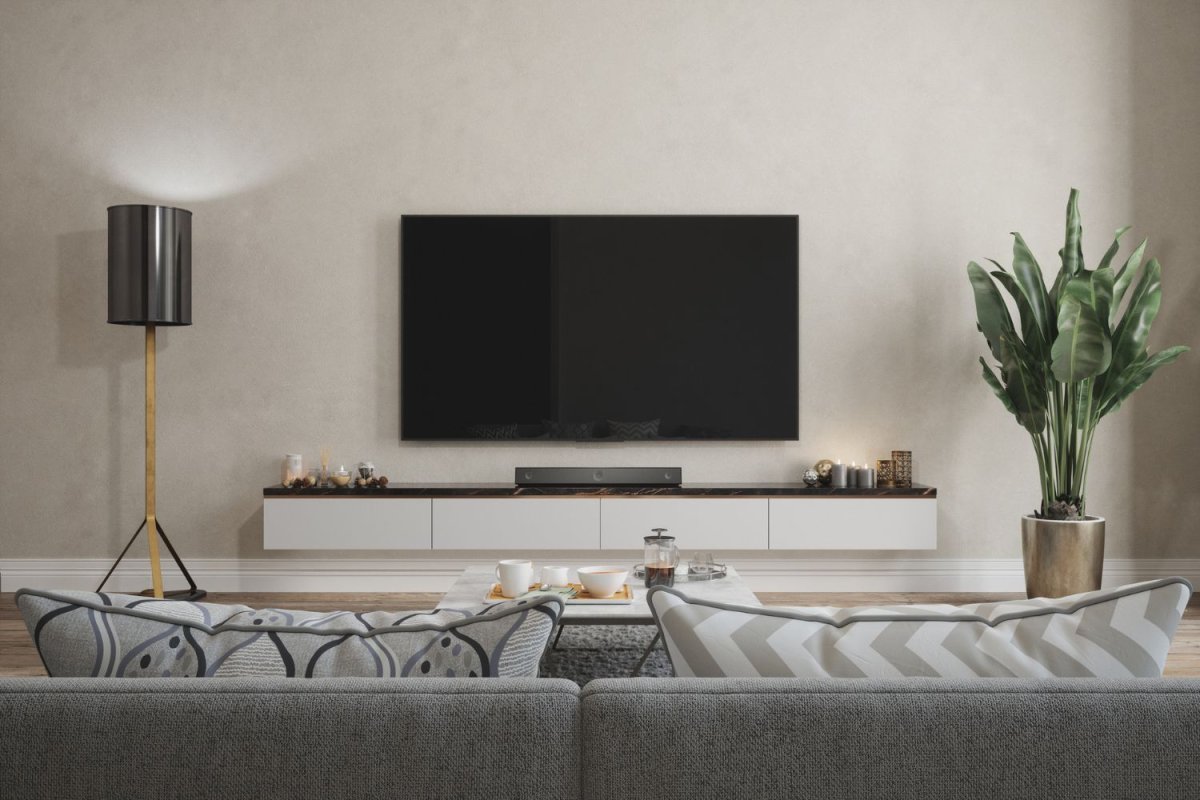

We may earn revenue from the products available on this page and participate in affiliate programs. Learn More ›
Highlights
- The average cost range to repair a TV screen is between $200 and $1,000.
- There are several factors that determine the total cost for TV screen repair, including the type and brand of TV and the cost of labor.
- A TV may be in need of screen repair if there is sound but no picture, color distortion, flashing pixels, or cracking on the screen.
- Someone with professional experience repairing electronics may be able to fix a TV screen themselves, but most people will want to call a professional.
While the average TV repair cost can range between $60 and $250, screen repairs are typically more expensive. According to Angi, TV screen repair costs run from $200 to $1,000. The wide span in pricing has to do with local labor costs, replacement parts, diagnostic and transportation fees, and the type of TV. Is it worth fixing a cracked TV screen? The cost to repair a television screen will often be more than the cost of buying a new TV, but it’s worth it to get a repair quote since some screen problems can be fixed easily for a budget-friendly rate. If the TV is still under warranty, the screen may be a candidate for repair at a reduced price, although many television warranties do not cover damaged or cracked screens. Many people may decide it’s not worth it to pay more than 50 percent of the original cost of the television just to have it repaired and will look for the best TV deals on a new model.
Those who are interested in finding places that fix TVs can do an online search to find reputable television repair professionals in their area. This guide will examine the factors that influence TV screen repair cost, additional costs and considerations, the different types of TVs, and some frequently asked questions about TV screen repair cost.
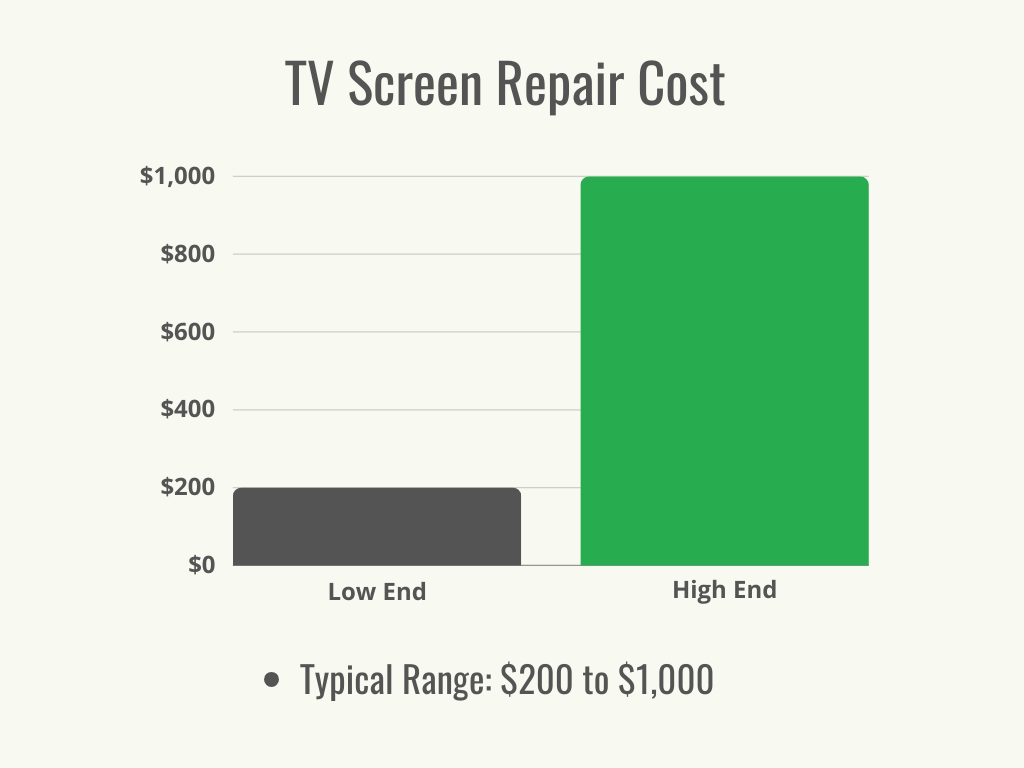
Key Cost Factors
How much does it cost to repair a TV screen? Cracked TV screen repair cost depends on a few important factors that can include the TV type, TV brand, local labor prices, and repair shop costs and fees.
TV Type and Brand
The type of television that needs repair is one of the major factors that influence cost. Newer and more technologically advanced TVs will typically cost more to repair, although older television models may be expensive to repair if the parts are hard to find. Keep in mind that repairs or screen replacements on some types of TVs may not be possible. Some of the most common types of televisions include flat screen, LCD, LED, 4K, OLED, plasma, and smart TVs. If the television is much larger than 55 inches, which is the average TV size, this can also make the repair more expensive.
Even TVs from the best TV brands may need repairs. Some people may decide to buy a specific brand of television because of the resolution, individual features, technology, or cost. The brand also directly influences repair rates because of specific problems that may be related to a manufacturer. Below are some of the most common brands of TVs found in homes and the average price range for repairs.
Problem Type
Repair costs will depend greatly on what is wrong with the TV. For example, damaged cables can be replaced fairly simply, so costs are relatively low at $75 to $200. Repairing a minor crack in the TV screen might cost several hundred dollars, but costs could reach $1,000 for shattered TV screen repair. Even the best outdoor TVs can succumb to water damage, in which case repairs could cost up to $500 as multiple parts may need to be replaced. Other common problems include the TV not turning on (or turning off spontaneously), not having sound, the screen lighting up and going blank, lines appearing on the screen, or screen cracks.
| Problem Type | Repair Cost (Materials and Labor) |
| Cracked screen | $400 to $1,000 |
| Damaged cables | $75 to $200 |
| Horizontal lines | $150 to $475 |
| No sound | $75 to $475 |
| Not turning on | $60 to $475 |
| Screen lighting up and going blank | $100 to $475 |
| Turning off spontaneously | $100 to $475 |
| Vertical lines | $150 to $400 |
| Water damage | $150 to $500 |
Labor
Labor costs are usually a significant part of TV repair costs. In most cases, a TV repairman will charge between $60 and $125 per hour, and some may charge a flat fee between $90 and $300, depending on the type of repair. If the repair work is completed within the home, a trip fee may be added to the total bill. For TVs that need to be taken into a repair shop but are too large to fit into a car, a transportation fee will commonly be added for the TV’s pickup, drop-off, and return. The average TV repair usually takes between 1 and 3 hours.
While some TV repair shops provide a free estimate of what needs to be repaired, others will charge a diagnostic fee. This fee can range from $40 to $85 or more, but some repair shops will waive the fee if they make the repairs. It’s recommended to get an estimate from the television repair service in writing and ask up front if there is a diagnostic fee to avoid any surprise charges.
Additional Costs and Considerations
When budgeting for TV screen repair costs, customers may find that there are additional costs and considerations that can change the overall price. These can include a diagnostic fee, the difference in pricing between repair and replacement, at-home repair versus in-store repair, required additional repairs, and warranty coverage.
Repair vs. Replacement
Repairing a cracked TV screen typically involves replacing the entire display panel. There are some flat-screen issues that can be repaired, so it’s always good to check with a repair professional to see if a screen can be repaired or if it’s a good candidate for a TV screen replacement. If a screen is severely cracked, chances are it cannot be repaired and it would make more financial sense to replace the TV instead of opting for a screen replacement. Most times, the cost of a TV screen replacement is more expensive than the cost of buying a new TV. However, replacement costs will depend on what size TV is needed and if it has any special features. Additionally, there might be a cost to mount the new TV with one of the best TV wall mounts. When the time comes to replace a TV, it’s also important to know how to properly dispose of an old television.
At-Home Repair vs. In-Store Repair
At-home TV repair typically costs more than in-store repairs. The pricing is more expensive due to the travel costs that are added to the bill. In-home repairs usually cost between $30 and $100 per hour for labor plus a trip fee. If the parts are readily available, many TV repairs take between 1 and 3 hours. If the TV requires additional repairs and needs to be transported to the repair shop, a transportation fee of $40 to $60 may be added to the total. Some repair companies will pick up and drop off the TV for no additional cost, so be sure to ask if there are additional charges for that service.
Additional Repairs
Sometimes a TV will need additional repairs for it to work properly. Below are some common TV display repairs and the average cost for each.
| Type of Television Repair | Average Price (Materials and Labor) |
| Backlight | $100 to $150 |
| Bulb | $60 to $115 |
| HDMI port | $95 to $350 |
| Inverter | $100 to $200 |
| Panel | $200 to $400 |
| Power supply board | $200 to $400 |
| Speaker | $75 to $250 |
- TV backlight repair cost. A TV backlight provides color and brightness by illuminating the display panel. If it’s broken, the TV will be half or fully dark when turned on or appear black. Black screen TV repair costs between $100 and $150.
- TV bulb replacement cost. TV bulb replacement can cost between $60 and $115 including the price for replacement bulbs as well as labor. Bulbs are used in older projection TVs or LCD TVs to illuminate the display. This is the most common type of repair if there is sound when the TV is on, but no picture.
- TV HDMI port repair cost. HDMI port repair costs from $95 to $350. A common problem with an HDMI port is that it’s fallen out of position, but the circuit board that connects to the HDMI port could also be damaged. Circuit board repairs range from $200 to $350, including labor.
- TV inverter repair cost. A TV inverter powers the backlight so a picture can be seen on the screen. It’s common for an inverter to be replaced rather than repaired and in some cases, the capacitors can be replaced when they fail instead of the entire inverter needing to be replaced. TV inverter repair can cost between $100 and $200, including parts and labor.
- TV panel repair cost. The cost to repair a TV panel is between $200 and $400. Many times the panel cannot be repaired and the owner will have to buy a new TV. If the cost of repairs is comparable to the cost of buying a new TV, oftentimes the repair technician will recommend forgoing the repair and buying a new model.
- TV power supply board repair cost. A TV power supply board is in charge of turning the TV on and off. These types of repairs can cost between $200 and $400. There are instances where a repair professional can replace individual capacitors instead of replacing the power board, but it’s typically more cost-effective to replace the entire board (or the entire TV) instead of spending the time diagnosing which capacitor needs to be replaced.
- TV speaker repair cost. Repairing the speakers on a TV runs from $75 to $250, depending on whether the speakers need to be rewired, replaced, or cleaned.
Warranty
Before paying for TV screen repair, the customer will want to check to see if the TV is still under the manufacturer’s warranty, then see if screen repairs or screen replacement costs are covered. It’s common that warranties do not cover TV screen damage due to accidents or neglect. For example, not cleaning a TV screen the right way could void the warranty. Extended warranties will sometimes cover defective parts or a malfunctioning screen. Purchasing an extended warranty typically costs between 10 and 20 percent of the original cost of the TV, and it will be void if a DIY repair is done on the TV.
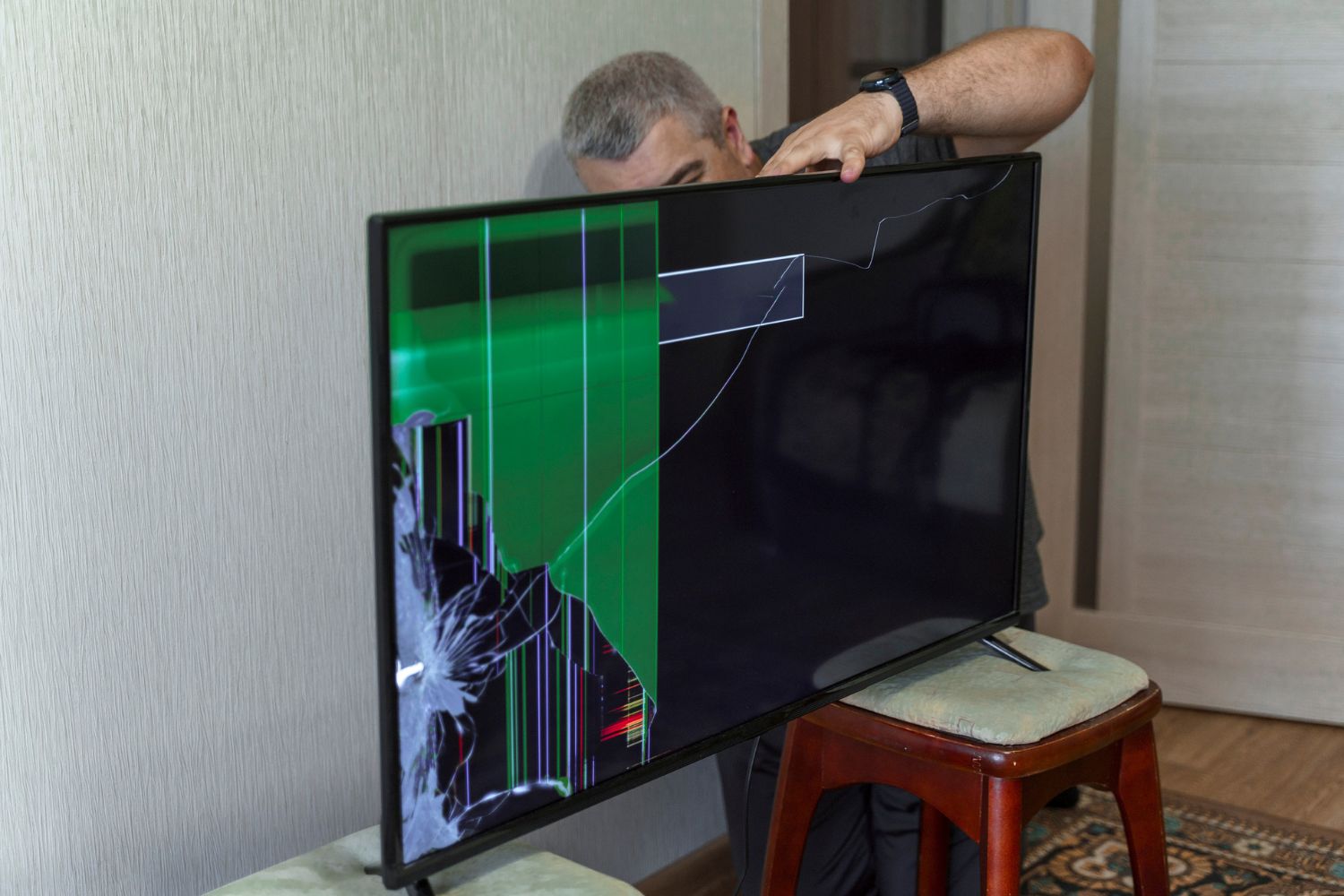
Types of TVs
The type of TV directly influences the cost of broken TV screen repairs. Newer and more advanced TVs are typically more expensive to repair, although there are times when the more technologically advanced TVs might not be able to be fixed. Below are the most common types of TVs and the average prices for repairs.
| Type of TV | Average Screen Repair Cost (Materials and Labor) |
| 4K | $100 to $350 |
| LCD | $60 to $475 |
| LED | $60 to $475 |
| OLED | $100 to $1,000 |
| Plasma | $200 to $485 |
| Smart | $100 to $475 |
4K
A 4K TV has some of the most detailed images available on a TV due to the high screen resolution. Some 4K televisions employ OLED (organic light-emitting diodes) or LED. Since the screen cannot be repaired on this type of TV, 4K TV screen repair cost is not an issue; the entire unit will need to be replaced. The average cost of other repairs for a 4K television runs from $100 to $350. Some common repairs for a 4K TV include the inverter, control board, or LED backlight strips.
LCD
LCD screen repair cost ranges from $60 to $475. LCD TVs use a liquid crystal display with backlights to display an image on the screen. Older LCD TVs may use CCFL backlighting. If the CCFL backlights fail, a repair technician may have a difficult time finding replacement parts, but they can replace them with LED backlighting. This type of TV is very popular, and these TVs come in a wide range of styles and sizes to fit any room. It’s common for the screen, backlights, and various other components to need repair over time.
LED
LED TV repairs run from $60 to $475, depending on the scope of the repair. LED TVs are a type of LCD that utilize LED backlights to light up the liquid crystal display. These types of TVs are usually more energy efficient and produce more vibrant and colorful images on the screen. It’s common for the LED backlights to need repair or replacement over time. The cost to replace one LED backlight strip ranges from $100 to $125, including labor and parts.
OLED
Repairs to an OLED TV run from $100 to $1,000. As the step above a standard LED TV, an OLED television has a higher contrast and blacker blacks on screen. OLED TVs are typically expensive to buy and to repair.
Plasma
Some plasma TVs can be repaired, and it typically costs from $200 to $485 for repairs. Plasma televisions are constructed of gas-filled pixels that light up with an electric current. While not as popular now as they were in the early 2000s, plasma TVs built between 2004 and 2009 are known as being more difficult to repair. Some repairs can be more expensive due to shipping and delivery of individual parts and local labor pricing.
Smart
Smart TVs connect to a home’s Wi-Fi network to download and run apps and various updates. While they are more technologically advanced than other types of TVs, they still have parts that break down and need repair. The average cost to repair a smart TV is between $100 and $475. The cost of smart TV screen repair depends on the specific problem and whether it can be fixed. Customers will want to keep in mind that the cost of some TV screen repairs far exceeds the price of a new TV.
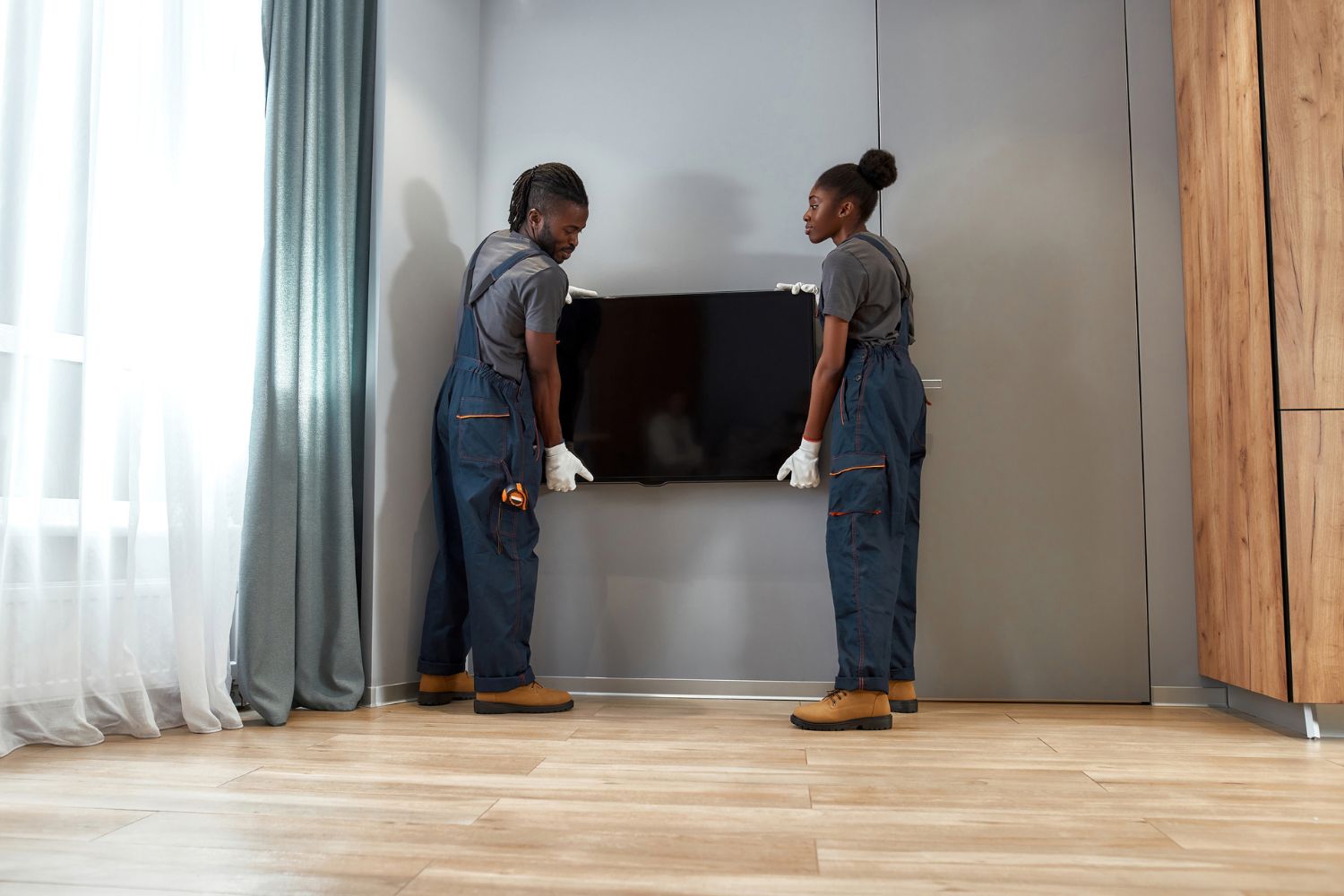
Do I need TV screen repair?
Busted TV screen repair can cost between $200 and $1,000. Some screen problems are severe enough that it makes more financial sense to buy a new television instead of investing in an expensive repair. However, there are problems that warrant calling a professional television repair technician to take a look at the damaged TV screen.
Cracked Screen
The TV screen is one of the most expensive parts of a television to repair. If the TV screen is smashed, it makes more sense to replace the TV with a new model since the cost of repairs will likely be more than the cost of a new TV. But if the damage is minor, repairs may only be around $200, which may be less than the cost of a new model.
Sound But No Picture
If the TV is turned on and there’s sound but no picture, some of the most common reasons would be burned-out LED or CCFL backlighting, a bad bulb, or the inverter needs to be replaced. The average cost to replace backlighting runs from $100 to $150, from $60 to $115 to replace a burned-out bulb, and between $100 and $200 for a new inverter, including parts and labor.
Color Distortion or Flashing Pixels
Relatively minor screen problems like color distortion or flashing pixels can sometimes be repaired, but it’s important to remember that some fixes aren’t possible, and the cost of repairs may be more than the cost of replacing the TV. Television screens are the most expensive part of the unit, and a repair technician may advise replacing the TV instead of spending between $200 and $1,000 for a repair. If the issues are due to a defect or malfunction, the warranty may cover the price of repairs.
DIY vs. Hiring a Professional
While it might be tempting to fix a television issue as a DIY project, it’s often best to leave the repairs to a professional unless the TV’s owner has professional experience repairing electronics. For those not comfortable with the repair process, it’s recommended that a customer contact a reputable local repair shop or one of the best appliance repair services to take a look at the TV and see if it can be repaired. Since there is always a risk of electrocution or damaging the television even more by improperly making repairs, it’s not a bad idea for a customer to call a pro to handle any TV screen issues. Customers will want to keep in mind that the television manufacturer’s warranty may be void if a DIY repair is attempted.
How to Save Money
The cost of repairing home appliances or a damaged TV screen can be a budget-friendly alternative to buying a new television—unless the screen is cracked; then the price of repair would be more expensive than replacement. There are several tips customers can implement to save money on the cost of fixing a TV screen.
- Get multiple estimates. Get at least three estimates from local reputable television repair shops in your area to find a price that works with your budget.
- Check the warranty. Check the manufacturer’s warranty to see if TV screen issues are covered. If the screen display is malfunctioning or defective, you may qualify for a replacement.
- Use the 50 percent rule. If the price of repairs totals 50 percent or more of the original cost of the TV or the price of a new model, it would make more financial sense to buy a new television with a good warranty.
- Transport the TV yourself. You can save money on pickup and delivery fees if you take the broken TV to the repair shop on your own.
- Request to use salvaged parts. If the repair shop offers the option of using salvaged parts from other TVs, you can save money compared to buying new replacement parts.
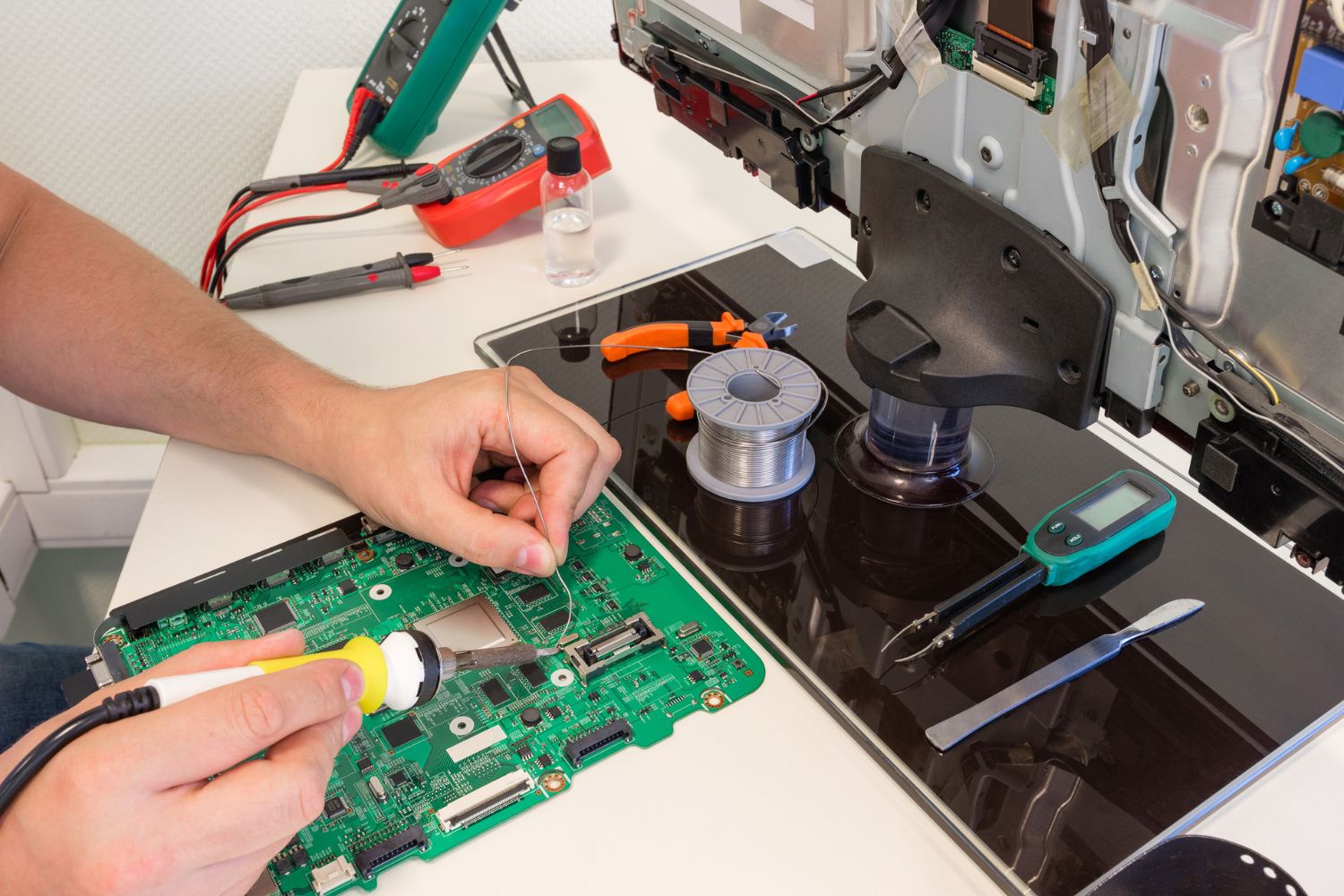
Questions to Ask a Pro
Asking a television repair professional the right questions can help avoid miscommunication and save money. By asking the following questions, customers can better understand TV screen repair costs and the various steps of the process.
- Are you insured?
- Is the repair company bonded?
- Are the TV repair technicians certified?
- Will you provide references?
- Do you have examples of previous TV repair jobs?
- Do you offer free repair estimates?
- What brands of TVs do you repair?
- What types of TVs do you repair?
- Can you fix TV screens?
- Do you background check your television repair technicians?
- What type of training do your TV repair technicians receive?
- Who will come to my house to repair the TV?
- Does your company perform same-day television repairs?
- Do you offer salvaged television parts as a money-saving option?
- Do you use genuine brand-name television replacement parts?
- Is the television worth fixing?
- Are your repairs covered under a warranty?
- What other services do you provide?
- How can I leave a review of your work?
FAQs
Repairing a broken or malfunctioning TV screen is a good way to save money, and many people have questions regarding televisions and the repair process. Below are some frequently asked questions about TVs and TV screen repair to help guide the decision-making process.
Yes, flat-screen TV repair is possible, including issues with the screen. A flat-screen television typically can’t be repaired if the screen is cracked or severely damaged.
Flat-screen TVs are rated to last approximately 100,000 hours, or 10 years, on average.
It’s not recommended to leave a TV on all night because of the risk of overheating. Overheating could cause damage to the internal components and the screen.
Some minor screen issues can usually be repaired, but since the screen is the most expensive part to repair, sometimes replacing the TV makes more financial sense. Some types of TVs have internal parts that can be damaged when a screen repair is attempted, so it’s recommended to have a professional repair tech handle any repairs.
No, turning the TV off does not shorten its life. It’s not recommended to leave the TV on all the time since it can cause overheating and damage to the internal parts.
Modern smart TVs are often designed to be energy efficient. The amount of energy used is different for each television brand and type.
Angi, HomeAdvisor, Fixr, HomeGuide
